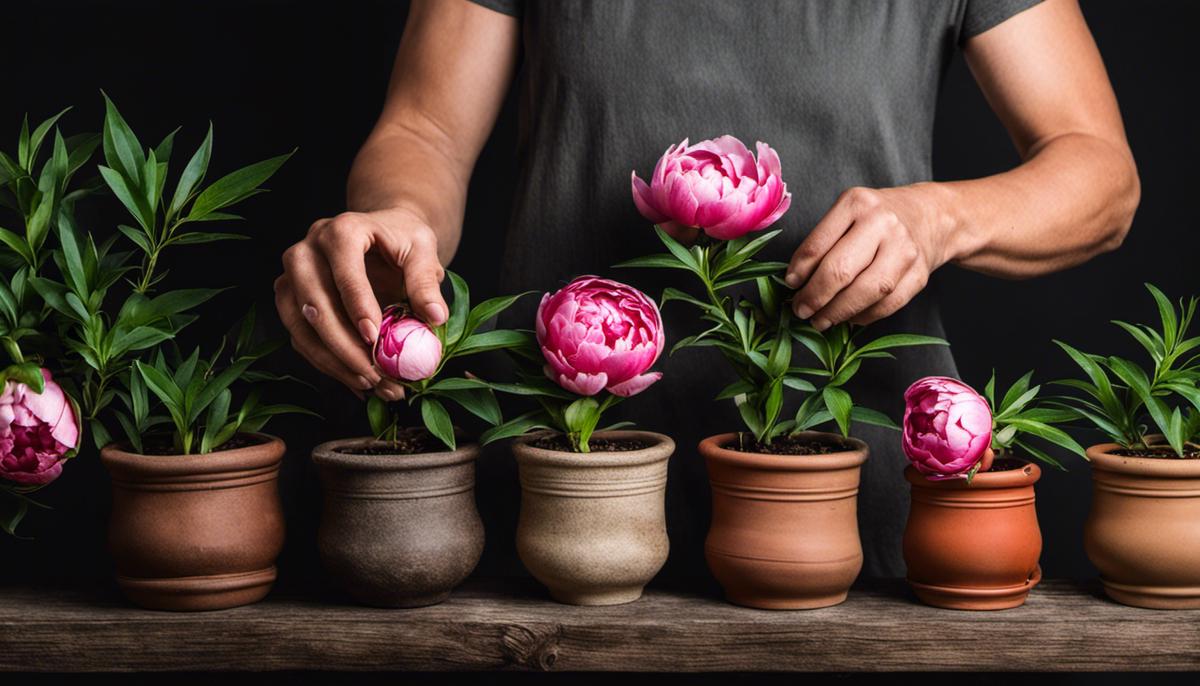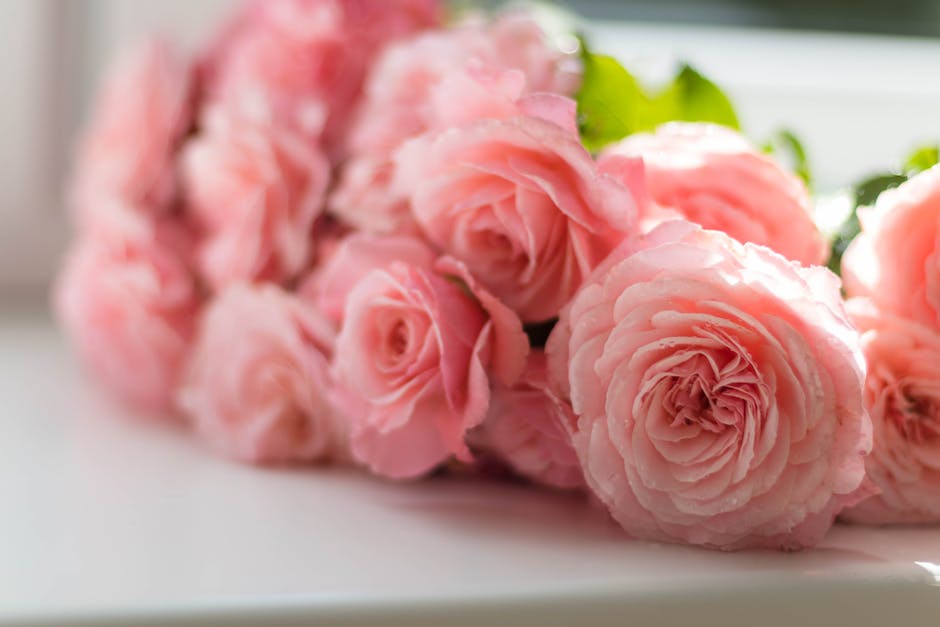Grow Peonies in a Pot with Ease

There’s something rather enchanting about peonies – their fragrant, lush blooms are a pure delight in every garden. But what if you have limited space or you live in an urban environment with no backyard? The good news is, peonies can indeed be successfully grown in pots. Choosing the right pot is a significant first step in this process, as the size, material, and drainage capabilities of the pot can greatly influence the health and vitality of your peony. Furthermore, understanding the specific care requirements for peonies, from sunlight and watering to fertilizers and pest control, is equally vital.
Choosing the Right Pot
The Perfect Pots for Peonies: A Comprehensive Guideline
Few things in the gardening world rival the joy of nurturing peonies – those lush, deeply fragrant blooms that encapsulate the very essence of spring. But as most peony aficionados understand, selecting the right pot plays a pivotal role in the health and bloom output of these colorful stately flowers. So, what factors should you consider when selecting a pot for peonies? Here’s the lowdown.
- Material: The first aspect worth considering is the material of the pot. Clay pots are highly recommended for peonies because they are porous, allowing roots to breathe while regulating both temperature and moisture– factors that significantly enhance peony growth. Terra-cotta pots are excellent options too for their heat retention qualities, but they tend to dry out faster, demanding more frequent watering.
- Size: Size is another crucial factor when choosing a pot for peonies. Despite being robust growers, peonies have relatively shallow, horizontally spread root systems. Pots should, therefore, be wide rather than deep. Opt for pots with a diameter of at least 1.5-2 feet and about 1 foot deep. This space provides ample room for the roots to grow and spread, thus ensuring the peony plants thrive.
- Drainage: Peonies despise waterlogged soil and are susceptible to root decay if overwatered. Pots with good drainage are hence fundamental to peony health. Make sure your chosen pot has several holes at the base. For metal or plastic pots lacking adequate drainage, drilling a few holes can resolve the issue.
- Weight: Remember, peony plants can get top-heavy when they start to bloom. Sufficiently weighty pots are essential to keep the plant from tipping over. If you’re choosing a lightweight pot for easy maneuverability, you may need to compensate with heavier soil or strategically placed stones on the bottom.
- Color: Though not an absolute necessity, color can influence the plant in certain conditions. For those living in hotter climates, lighter colored pots are ideal as they absorb less heat, thus protecting the roots from overheating.
- Maintenance: While peonies are low-maintenance, the pot you choose may not be. Wooden pots can rot, while clay pots can crack due to temperature extremes. Choose a pot that suits both your climate and commitment level.
In conclusion, the perfect pot for peonies is one that fits the plant’s physical requirements while also suiting your gardening availability and lifestyle. It should provide adequate space, drainage, and weight, and be made of material that promotes a healthy growing environment. So, choose wisely, and let the delight of peony growing commence!

Understanding Peony Care
Having tuned into the nitty-gritty attributes such as material, size, drainage, weight, color, and maintenance of the perfect flower pot, it’s high time to delve deeper into this fascinating world of potting plants. Let’s now steep ourselves in an equally important aspect of this rewarding hobby: the essentials of preparing and planting in a flower pot.
Before even thinking about bringing a plant into the picture, it’s crucial to fill the pot correctly. Whatever the plant, it is a sure thing it will appreciate a good drainage system. A layer of small rocks, pebbles, or broken pottery placed at the bottom of the pot can assist in keeping roots from drowning. This layer won’t only foster superior drainage but will also prevent soil from washing out of the drainage holes and dirtying your patio or indoor surfaces.
Coming to the soil, it’s highly recommended to use a good-quality potting soil mix instead of digging up dirt from the garden. The gardener’s delight lies in recognising that the keyword here is “mix”. A perfect blend allows sufficient moisture and nutrients for the plant’s growth while providing excellent aeration and drainage. A great potting mix usually contains peat moss, vermiculite or perlite, and organic matter, creating a light and fluffy environment for roots to thrive.
Next, comes the act of planting the flowers itself. You may ask, ‘How deep should I plant?’ Well, with the exception of a few specific plants, most prefer to be planted at the same depth in the pot as they were previously. Make it a point to leave a little room at the top of the pot for watering. Roughly, around half an inch to an inch from the soil surface to the rim of the pot should do the trick.
Watering is an art that hobbyist gardeners perfect over time. It’s vital to water the plants after planting to settle the soil around the roots and to reduce transplant shock. Generally, potted plants dry out faster, requiring more frequent watering. However, overwatering can be detrimental, leading to root rot. The thumb rule here – check the moisture level of the soil before going ahead with watering.
Finally, the joy of potting is complemented by a dash of fertilizers. To keep the beautiful blooms blooming, a quality, all-purpose, slow-release fertilizer can be mixed into the soil once at the time of planting and then be applied monthly as per the instructions on the package.
After these easy steps, all there’s left to do is to sit back, behold the beauty of the plant, and relish the satisfaction of having created it single-handedly. It’s only a matter of time before your space starts to bloom and your heart swells with pride. Don’t forget that each flower pot is like a tiny universe of its own, and as its god, only you can take the best care of it.

Planting Peonies
With our pots meticulously selected for the successful thriving of our peonies, let’s march boldly onward to the planting stage!
Now, here’s a fancy phrase to impress all your gardening buddies: “Eyes facing skywards!” Sounds magical, doesn’t it? Well, in simpler terms, it merely means positioning the peony roots so that the buds or “eyes” face upwards. And why do we do that, you ask? For one glorious purpose which will keep your peony cheering all season: Photosynthesis.
Now, eyes up or down isn’t the only thing that matters. Depth of planting is also crucial. If there’s one secret every peony planter must uncover, it’s this: Not too deep, please! A depth of 2 inches is ideal. Any deeper, and your beautiful peonies might go into a perennial state of snooze, refusing to bloom.
Use potting soil that’s high in organic matter. A mixture of soil, compost, and peat moss will do wonders. This magical trio creates the ideal environment for your peonies to thrive, boosting both water retention and drainage. Spread a layer of this mix at the bottom of the pot before placing the peony tuber.
Correct watering techniques are vital and straightforward. Overwatering can lead to crown rot, while underwatering can cause wilting. The trick lies in watering thoroughly and then allowing the soil to dry out before the next watering. Be wary of rain if your pots are outside, as this can affect the drying out phase!
Let’s delve into some fertilizer facts! Peonies love a meal of balanced, slow-release granular fertilizer. After your peonies have been comfortably nesting in their pots for a couple of weeks, feeding them this fertilizer helps them grow robust and healthy while producing some show-stopping blooms! Remember though, moderation is key! Overfertilizing can cause more harm than good.
All these methods, when performed with routine and love, ensure the perfect blend of conditions that allow potted peonies to flourish. Cultivating these lovely plants might require some effort and patience, but the result is ever so gratifying – vibrant, colorful blooms bringing cheer to any space they occupy.
Take it a day at a time, follow these steps, and soon enough, you’ll find yourself transformed into a seasoned Peony whisperer. Oh, the joy derived from seeing these buds burst into full bloom! It sparks a profound sense of accomplishment and satisfaction that only fellow hobbyists would understand. And in that moment, you are not just a Peony planter but someone who breathes life and color into the world. So, pull on those gloves, wield that trowel, because it’s time to pot some peonies!

Growing peonies in pots is a wonderful opportunity to enjoy these beautiful blooms in any space. Indeed, the journey from choosing the right container to understanding the peony’s specific growth requirements and finally planting, is a rewarding learning experience. Each detail, from pot size to the depth your peonies need to be planted at, plays a role in the success of your gardening project. Armed with a bit of knowledge and patience, you can create a captivating green space in your home with flourishing peonies, welcoming the joy and beauty of nature indoors. Happy gardening!



